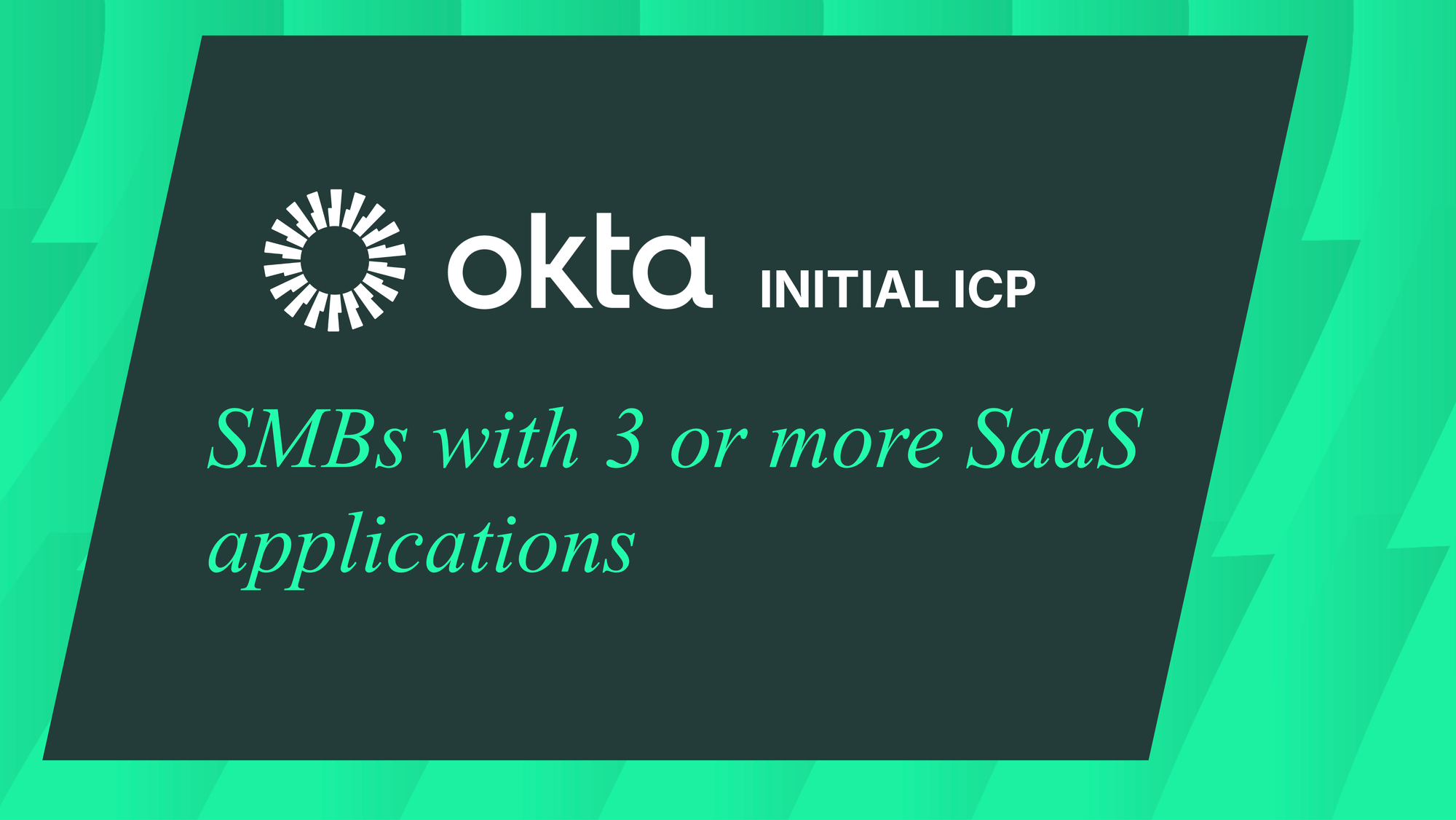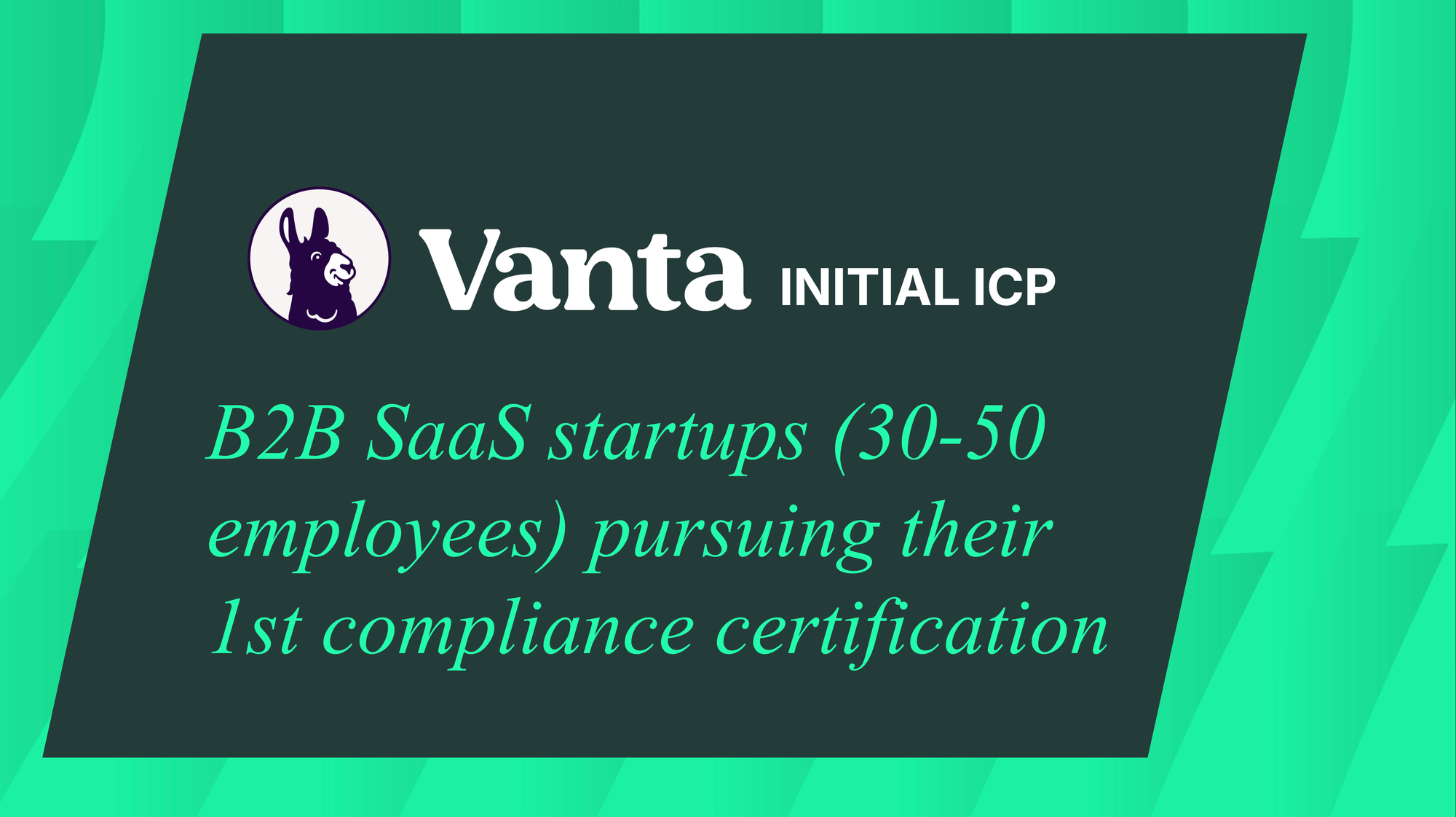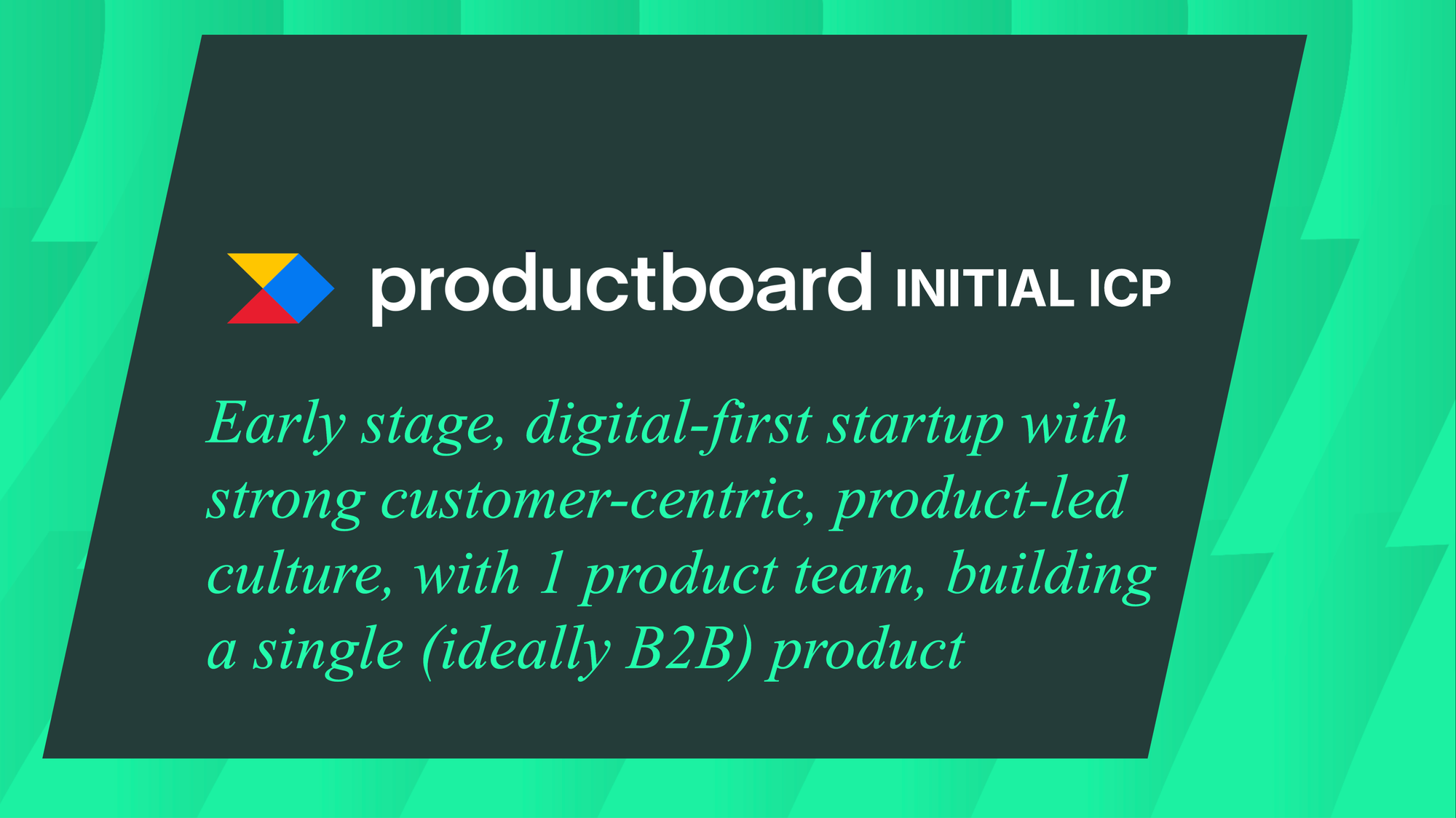Choosing a radically specific ICP seems like it goes against every founder’s instinct. You’re trying to find as many customers as possible who want your product, so why would you turn them away at the door? It feels wrong. It feels scary.
When I sit down with founders, I see this all the time: they’re so eager to make progress that they lock in on their first interested customers (or, let's be real, their friends) as their default ICP. And sure, this can work for a while.
But the consequences surface months later, when you're stuck with a scattered customer base that pulls your product roadmap in opposing directions. The “all things to all people” approach makes your messaging feel generic and adds customer logos to your site that are mostly irrelevant to your prospects.
You need to get to know a singular buyer profile well enough that you can nail your sales pitch to 10 more.
A proper ICP gets uncomfortably specific — down to the company stage, industry, buyer persona, current solution and even trigger events that make them buy. It should be so narrow that when you describe what you’re building to friends and who it’s for, they think you're slightly crazy for trying to do something so niche.
This advice applies even if you’re in the very earliest stages of building. Even if the “product” is just a few mockups on a slide deck, we challenge founders to define a working hypothesis for their company. The hypothesis (which, at First Round, we call “the 4 P’s”) includes:
- The Person who will use or buy the product
- The Problem they need solved
- The Promise or value proposition of the product
- The Product description
This hypothesis starts with the person who would use their product.
It takes hundreds of customer conversations to achieve this level of clarity (and yes, your hypothesis will probably change countless times along the way). But eventually, you start to feel the visceral difference between prospects who desperately want your product and those who merely find it "interesting." Identifying those superfans puts you in pole position to build with focus and sell with consistency. You’ll drive faster in a straight line, not zig-zagging across different lanes on the track.
Your ICP is not anyone with a budget. It’s people who see your product and think, “This was made for me.”
To put this idea into practice, we sat down with founders to learn exactly how now-massively successful startups found their ICP. But here’s a spoiler: for founders of unicorns like Okta, Vanta, and Clay, their first crack at an ICP was way off the mark. They share the frameworks and tactics that worked for them to pivot their way into the right ICP (before eventually casting a line into much deeper waters), and how you can apply their hard-won lessons to your own search.
Here’s who you’ll learn from:
- Christina Cacioppo, co-founder and CEO of Vanta
- Kareem Amin, co-founder and CEO of Clay
- David Hsu, founder and CEO of Retool
- Waseem Daher, co-founder and CEO of Pilot
- Bryant Chou, co-founder and Chief Architect of Webflow
- Eric Berg, former Chief Product Officer at Okta, now CEO of Fauna
- Hubert Palan, founder and CEO of Productboard
- Mike Molinet, founder of Branch and now building Thena
Let’s dive in.
The case for starting small: Okta’s story
Back in 2010, orgs were still pretty nervous about moving their SaaS applications onto the public cloud. This was the world that Okta stepped into with its identity and access management service. These days, Okta counts two-thirds of the Fortune 100 as customers. But that’s not even close to where they started with their ICP.
Here’s how former Chief Product Officer Eric Berg (who joined as employee #10) breaks it down.
“We did not go after large enterprises in the beginning. They might have had a couple of applications in the cloud, but relative to their overall infrastructure, it wasn’t very important compared to SMBs. So our ICP was SMBs that had three or more SaaS applications,” he told my partner, Brett Berson.

Here’s why it paid off. “It’s easier to build a more scalable business and to get started on a problem that a large number of small customers have. You tend to find that their requirements are more consistent, so you can hone in on a smaller feature set. That’s a clearer product roadmap.”
If you have five large global enterprises that all want different things, that makes it harder to build a consistent product.
-Eric Berg, former CPO of Okta & CEO of Fauna
“As you start to expand beyond that initial ICP, the good news is that these markets are often like layers of an onion. You'll find that your core solution still matters to bigger customers. They just need a few extra things on top,” says Berg.
That’s exactly how Okta grew: “As we expanded into larger enterprises, we found that bigger companies needed the same basic things – they were adding SaaS apps and needed to connect them to their corporate directory. They just needed extra features for their more complex environments and on-prem systems,” he says.
Imagine a better world for your ICP: Vanta’s story
When Vanta's Christina Cacioppo was exploring startup ideas, she initially went down a voice assistant rabbit hole (it makes more sense when you realize this was 2016, just two years after Alexa had launched to great fanfare). She tried a mic for transcribing notes into Slack and even a voice assistant for biologists working in a lab ("the market was the size of my thumb and I didn't even know anything about biologists," she admits).
Finally, she hit pause on building and tried something entirely different: talking to people. She dug into their daily routines, pored over their calendars, and asked about their weekly highs and lows. She was hunting for a problem big enough to be worth solving.
One thing kept coming up in conversations, usually accompanied by groans and eye-rolls: security compliance.
So she started asking everyone she met – founders, security folks, engineering leads, sales teams — one simple question: "What are you doing for security at your startup?" The response was almost always the same: a guilty look and a sheepish, "Not that much, and I wish it were better," she told my partner, Todd Jackson.
Startups were stuck between two choices:
- Put their already-scarce resources into building security features. They knew this was important, but its ROI was the absence of a security breach, which wasn’t a compelling metric compared to…
- Allocating resources to growing the business, like building features customers wanted and getting their first few million in revenue.
These small startups (who no one had heard of and would try to hack anyway, right?) were choosing the latter, every time. Well, almost every time — until Cacioppo met a startup that broke the mold and unlocked her ICP.
“There was this transformative moment when I walked into Figma, then just 30 people. I sat down with one of their infrastructure engineers, expecting to have the same conversation I’d had so many times before,” says Cacioppo. “But this time, when I asked, ‘What do you all do for security?’ this person listed about 12 tools and a bunch of best practices and just kept going. That floored me. I was like, ‘Why? Who are you and why?’”
Figma had just signed Google as a customer. As part of the sales process, Google had sent over a long questionnaire to assess Figma’s security practices. Instead of saying “no” to most of the questions, Figma turned the questionnaire into their product roadmap.
This led Cacioppo down a new path, straight to something called SOC 2 – basically an 80-page PDF that documents a company's security practices. For SaaS companies trying to land enterprise customers, this certification is make-or-break, proof that the data will be safe.
Instead of letting startups struggle with endless security questionnaires, what if Vanta could automate the SOC 2 process? Just one tiny problem:
Our pitch was “We're gonna go SOC 2 all the startups!” But at the time, no startup got a SOC 2.
-Christina Cacioppo, co-founder & CEO of Vanta
But Cacioppo had a hunch: if she could help startups move up-market and land enterprise customers by automating security, she'd be onto something big.
“Our thesis was that there was going to be more and more pressure on software companies to prove their security and that more startups would get a SOC 2 if it was easier,” she says.

Get over your commitment phobia: Clay’s story
The team at Clay ran into an entirely different kind of problem. Unlike Vanta, they weren't struggling to find their market – they were drowning in inch-deep potential markets.
Clay is a tool for connecting APIs to your spreadsheets to enrich your data, and everyone wanted a piece of it. Recruiters told founder Kareem Amin how useful the product was for finding candidates. Salespeople wanted to use the platform for their inbound and outbound leads. Front-end engineers could use the spreadsheet as a low-code backend.
All this interest might sound great, but five years in, revenue was still hovering near zero. The warning signs were there when the initial spark died off quickly. “People would feel excited by the possibilities the product opened. But they weren’t always going back and using it the next day,” Amin told us. “So actually we had a lot of, ‘Wow, this is so powerful!’ and then no usage, or inconsistent usage.”
The Clay team accidentally cast too wide a net by building features every prospect wanted. As Amin explains it: "When you're an early startup team, one of your strengths is that you're malleable. A prospect can say, 'Oh, could you guys do this?' or 'Are you guys this?' And then you can become that, quite easily. What I've learned is that you have to know when to be malleable,” he says. "You can't be changing the value prop or even the product itself from meeting to meeting."
When you narrow the scope, it feels claustrophobic. Why are we doing something that’s smaller when we could be doing something bigger? Eventually, we realized that by narrowing down our scope, we were actually increasing our value.
-Kareem Amin, co-founder & CEO of Clay
Finally, to escape the everything-to-everyone trap, Amin called a bold play: pick one specific ICP and go all in. They started with outbound sales teams.
“It wasn't so much that I was 100% sure that outbound was the right call, although it was a faster starting point because all companies need it, versus typically only bigger companies needing inbound support, ” says Amin. “It was more that I realized we need to pick one thing at a time, test it out clearly and get feedback that we can react to quickly. That’s when we’d earn the right to execute on the more expansive parts of our mission.”
Like many startups, we eventually realized that we were ahead of the market in terms of what we thought the future should look like. But where we were weaker was in being able to say, “What do we need right now to move the needle tomorrow?” The lofty vision was overtaking what we needed in the present.
-Kareem Amin, co-founder & CEO of Clay
Just look at how Clay’s homepage compares from the horizontal vs. vertical approach:
Methodically test your assumptions: Retool’s story
Here's an impressive stat: Retool landed 40 customers and hit $2 million in ARR before they even launched publicly. How'd founder David Hsu manage that? By treating his ICP hypothesis like a science experiment.
The product idea was already set in motion — a drag-and-drop platform for developers to build internal tools faster (from customer support to fraud detection). But Hsu started with two big assumptions about who'd want it.
- Target user hypothesis FileMaker developers: “Since Retool is a product that’s kind of similar to FileMaker, Microsoft Access or Visual Basic, we thought we should go find similar customers and convince them to try Retool.”
- Company size hypothesis Tiny startups: “We thought our product could be a fast way for a small, two to three-person company to build their internal tools.”
As it turns out, both assumptions were dead wrong. Here’s the framework Hsu used to figure that out:
- Testing the target user To get into the minds of his potential target users, Hsu infiltrated several LinkedIn groups for FileMaker developers and launched a massive outreach campaign. The results didn’t point toward strong PMF. “We sent out a few hundred cold emails, received like three replies back and got one person on a call. That developer pretty much said that Retool is a horrible idea and wouldn’t ever consider using anything other than FileMaker.”
- Iterating on the company size As they dug deeper, they stumbled onto something huge: the market for Retool was significantly larger than Hsu and his team had originally anticipated. “We discovered that around 50% or 60% of all the software in the world is actually internal facing. And once we discovered that, we were like, ‘Wow, this is a ginormous market.’ If we can change the way that half of all software is built, that would be really incredible.”
Hsu iterated quickly and moved on to the next hypothesis. Lather, rinse, repeat. Until — finally — he got to the right ICP.
Retool’s new ICP:
- The right target user Through this process of iteration, the Retool team discovered that their target users were frontend and backend developers who work mainly in React or JavaScript. And while engineers notoriously hate drag-and-drop coding tools, it turned out they hated building internal tools more.
- The right company size Those small startups weren't the goldmine – big corporations were. “One of our early customers was a Fortune 250 company with around 120,000 employees, and they were spending $400 million building internal tools every year,” says Hsu.
Pressure test with a hard ICP: Pilot’s story
For the founders of Pilot, the most tedious parts of their first two companies paved the way for their third: No matter what you’re building, dealing with finance and accounting is a massive headache. With no money for a finance team, early-stage founders end up hunched over spreadsheets painstakingly doing their own books.
So after two successful startup exits (one to Oracle, another to Dropbox), for startup number three, the founding team landed on the idea for a monthly subscription bookkeeping service. As seasoned founders, they knew to pick an idea with a massive market — but also the challenges that come with expansive surface area. "One of the big challenges of Pilot is that the market opportunity is so large in every direction, and it would be quite easy to try to boil the ocean and be unfocused about what we do,” says Daher (echoing Clay’s Kareem Amin).
To avoid this trap, the Pilot founders narrowed their focus early, choosing the ICP literally one day after committing to build the product. As Daher puts it, "We didn't even have the name yet, we were like, 'Okay, we're going to do this bookkeeping, accounting thing for companies, and we're going to initially focus on startups.'"
This was intentionally putting their ICP on hard mode. “It’s a very hard version of the problem because the nature of the startups’ accounting needs are dramatically different. Two people in a garage is much different than 300 people with a VP of finance and a controller. We knew that it would pressure test the model and prevent us from over-fitting on one particular use case,” Daher says.
Find your line of sight into a bigger segment: Productboard’s story
Here's how sure Hubert Palan was about his idea for Productboard: he actually took a selfie to mark the moment. As a product manager, he'd been fighting with tools that weren't built for him. "Jira, GitHub, and all the great software at the time worked for engineers but didn't have what product managers needed: features for customer feedback and pain points. That made it difficult to build what mattered to customers."
But “PMs” was far too broad. To narrow in on his ICP, Palan grabbed his laptop, whipped up a rough prototype in Keynote, and started talking to anyone who'd listen.
After hundreds of conversations, he looked for patterns. Anyone who got excited about the prototype went into a spreadsheet, where he mapped them across seven key dimensions:
- Company size
- Product stage
- Digital-first or digital transformation
- Single product vs. multiple products
- Size of the product organization
- Care for the customer
- B2B vs. B2C
“I started to form this multi-dimensional model of the market and its different segments, and I made a very intentional decision that we were going to narrow the focus,” says Palan. Here’s how he defined Productboard’s early ICP:
- An early stage
- digital-first startup
- with strong customer-centric, product-led culture
- with one product team
- building a single (ideally) B2B product

It’s an ultra-specific target profile — and that was exactly the point. As Palan explains: "At the beginning, we were intentionally focused on very simple product teams.”
If you can create a plausible hypothesis that there are enough people that fit your initial segment, your job is to go and find those people. If there aren't enough people, then you have a problem because you don't have a line of sight for other bigger segments.
-Hubert Palan, founder & CEO of Productboard
Then Palan drops this gem of advice for other builders: "When you're looking for product-market fit, identify the criteria of your target segment. Of course, you need to be curious and talk to some people who you don't think are within your target segment, but you end up wasting a lot of time with people who are not the right people to talk to. You want to be kind and respectful, so you do the full-hour interview—and you shouldn't. You should just say, 'Thank you, but it doesn't sound like this is a good fit.'"
Pick the most disenfranchised user: Webflow’s story
Webflow didn't start with your classic lightbulb moment – it started with Vlad Magdalin tinkering. He was experimenting with a visual-first web app builder, trying to create something that would sit on top of frameworks like Django or Ruby on Rails. He got his brother Sergie involved, and by 2012, had committed to turning this side project into a real business. Then came a YC rejection (and a balance sheet nearly at $0), prompting them to bring in Bryant Chou as a co-founder to help figure out their next move.
Chou walked into a classic startup conundrum: a solution in search of its perfect problem.
“Vlad and Sergie were trying to reinvent how to build a web app in a visual way. But they just started with too big of a problem and too broad of a potential solution set,” Chou told us. The initial YC rejection was their signal to get more specific around their ICP and build a narrower solution.
Their breakthrough came when they started looking for the person getting the short end of the stick in web development: freelance web designers. One of the co-founders, Sergie, had been a freelance freelance graphic designer himself, and deeply understood just how painful the process was.
Here’s how Chou explains: "At the time, it was just an incredibly old-school process. There were Photoshop PSDs floating around with mockups of a website. Then you have to go find a developer to translate a PSD to HTML. So freelance web designer had to split 50% of their earnings to a developer to get their designs coded up. We just thought there's gotta be a better way."

But here's where it gets tricky: they weren't just entering a market – they were creating one from scratch. As Chou puts it: "We set out to focus and ride the waves of responsive web design, of mobile, of web consolidation around HTML5 and the rise of just how important design was,” he says.
We were trying to bring together two disciplines that never coexisted: web design and web development. And we were building a product for a designer-developer — a unicorn persona that there was no market for at the time. So we were, in essence, creating our own market.
-Bryant Chou, co-founder and Chief Architect of Webflow
I love this point from Bryant — you have to earn the right to get to the next stage. “When I looked at that initial YC application, it was just too broad. It was so horizontal. It was like, ‘we want to reimagine software development.’ And I don't think any of the YC partners at the time felt like we had a really firm grasp of the precise pain points that were looking to solve,” he says. “And the funny thing is, now the mission of the company is to bring development superpowers to everyone. So, in a way, we’ve gone full circle 10 years later.”
Find your lookalikes: Thena’s story
After scaling Branch to $100M, Mike Molinet is now back in the 0-1 trenches building Thena, a modern B2B ticketing platform. And this time around, he’s bringing some second-time founder wisdom to the ICP process.
Here’s how he’s going about it at Thena: “We sell to companies that are technical products selling to technical stakeholders, like API, SDK and security-type companies. That’s where we’re strongest,” he says. “Because the more technically complex your product is, the more acute need for ongoing engagement and support interactions. Versus if you have a basic set-it-and-forget-it sales structure, they could do one 30-minute presentation and never talk to you again. You don’t need an ongoing engagement with that customer, so you’re probably not going to have a support Slack channel.”
But identifying your ICP is just the start – you've got to turn that insight into action (and dollars). Here's the tactical approach to how Molinet did it: "We focused on account list building using Keyplay. Specifically, we map the companies that have bought us and then we create a list of 500 companies that match very similarly to the profile. It enabled us to focus and not just do a spray-and-pray approach. Account scoring and account matching made a big difference to us."
As we wrapped up our conversation, Molinet shared something that perfectly captures the journey every founder in this guide has taken:
You have to start with a hypothesis of what your ICP is — but it will change. Not may change, it will.
-Mike Molinet, founder of Branch and Thena
Like almost all things when it comes to startups, defining your ICP is not a check-the-box activity. As you move upmarket, expand your product feature set, and new competitors enter the ring, your ICP will need to evolve in quick succession.
The founders in this piece didn't succeed because they got their ICP right on the first try. They succeeded because they had the courage to get narrow, the humility to admit when they were wrong, and the persistence to keep iterating until they found their sweet spot. So pick a direction. Test it. And don't be afraid to change course.
You can catch future pieces in the 0-$5M series by subscribing to The Review or following me on X @BigMekaStyle.
